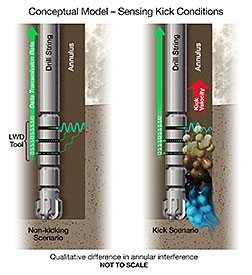- Number 446 |
- August 24, 2015
NETL's kick detection system provides early warnings for safer drilling

A kick within the wellbore, pictured on the
right, can damage equipment and endanger
workers and the environment.
The perception of oil and gas well control has evolved over the last century. In the late 1800s and early1900s, blowouts were held in high esteem, with “gushers” romanticized as a symbol of prosperity. Over time, however, these gushers became associated with the destruction of materials, human and environmental impacts, and a loss of marketable resources, leading to development of well control technologies.
Kicks provide the first indication that a well is becoming unstable. A kick can start as a slow leak from a pressured formation into the wellbore, but the flow increases as the influx of lower density reservoir fluid reduces the hydrostatic pressure exerted by the drilling fluid at the source of the flow. This causes the well to become underbalanced, requiring intervention for the operator to regain control. Failure to regain control usually results in a blowout.
The start of a kick is the optimum time to control the underbalanced condition. Industry has sought solutions to early kick detection and suppression for decades. The method commonly used for kick detection relies on monitoring the drilling mud properties and fluid returns as they come to the surface. However, if the kick is strong there may not be sufficient time to analyze kick-detection parameters before a decision to shut in the well must be made. A complementary method to detect pre-kick trends that offers accurate, direct measurement of key changes in wellbore and formation conditions in a timely manner could be indispensable to industry.
A new kick detection technique from DOE's National Energy Technology Laboratory holds promise for just this sort of complementary pre-kick detection. The primary goal of this technique is to maximize the amount of time available to the well operator to initiate well control and recovery procedures by detecting pre-kick trends near the bottom of the hole.
The technique uses highly sensitive, near-bit measurements from the logging-while-drilling (LWD) instrumentation that is already in use during drilling. Collected data that may be affected by kick fluids are transmitted to the surface, where they are compiled into a statistical algorithm. The algorithm develops data trends. Significant deviations from the expected measurement value are flagged by the algorithm, generating a notification which is sent to the driller. The algorithm sensitivity is modular and can be adjusted to satisfy specific drilling needs. This feature will minimize false detections, reducing costly rig downtime and work stoppages.
No modifications or additions to the drillstring are necessary to implement this technique, making it inexpensive and efficient to implement. The technique will use multiple, overlapping LWD measurements, reducing uncertainty whether a detected event is significant or not.
Early results are encouraging. Researchers are attempting to collect borehole data with documented kick events from operators to verify which LWD logs provide the best real-time, raw data to detect pre-kick trends. Opportunities also exist for an industry-NETL partnership to further develop this technology.
For additional information about NETL’s kick detection system, please visit https://edx.netl.doe.gov/offshore.[Linda Morton, 304.285.4543,
Linda.morton@netl.doe.gov]
